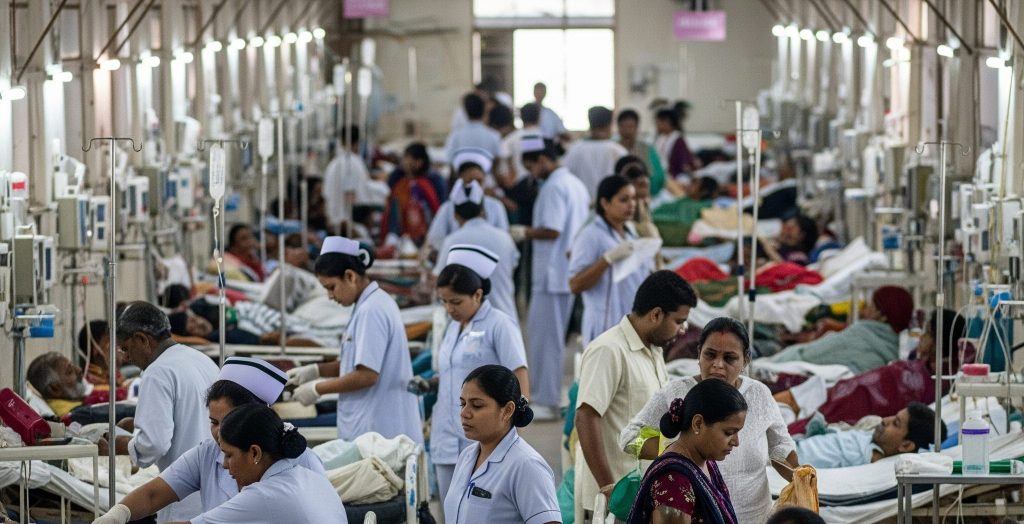India faces a diverse range of health challenges, with variations across states influenced by geography, socio-economic status, and healthcare accessibility. Beyond nationwide concerns, individual states contend with distinct health issues that necessitate tailored preventive and diagnostic approaches. Here’s an updated overview of major health problems in India at both state and country levels, along with current prevention methods and diagnostic procedures:
1. Non-Communicable Diseases (NCDs)
Countrywide Issue:
Hypertension, Diabetes, Cardiovascular Diseases (CVDs), and Chronic Respiratory Diseases continue to be India’s predominant NCDs. India bears a significant burden of CVDs, which remain the leading cause of death, followed by respiratory diseases and cancer. The contribution of NCDs to the total disease burden has significantly increased.
Preventive and Diagnostic Measures:
- Prevention: Promotion of healthy diets (e.g., through the “Eat Right India movement” by FSSAI), encouragement of physical activity, and robust tobacco and alcohol control measures. Public health programs like the National Programme for Prevention and Control of Cancer, Diabetes, Cardiovascular Diseases, and Stroke (NPCDCS) are crucial for promoting early screening among high-risk groups. ASHAs (Accredited Social Health Activists) play a vital role in community awareness, home visits, and health campaigns.
- Diagnosis: Early detection through regular screening of blood pressure, blood sugar, and cholesterol levels. Risk assessment tools and periodic health check-ups at Primary Health Centres (PHCs) are integral. The National NCD Portal facilitates screening data collection. Initiatives like Ayushman Bharat – Pradhan Mantri Jan Arogya Yojana (PM-JAY) and Pradhan Mantri Bhartiya Janaushadhi Pariyojana (PMBJP) aim to provide affordable diagnosis and treatment.
State-Level Issues (Illustrative Examples – while specific recent state-wise prevalence figures for NCDs are not readily available in the search results, the underlying factors persist):
2. Mental Health
Countrywide Issue:
India’s mental health crisis remains a pressing concern, exacerbated by rising stress levels and insufficient mental health resources. The country continues to report high suicide rates, particularly among youth and farmers. Mental disorders affect approximately one in seven people in India, and their contribution to the total disease burden has nearly doubled between 1990 and 2017.
Preventive and Diagnostic Measures:
- Prevention: Enhancing mental health education in schools and workplaces, actively de-stigmatizing mental illness, and expanding counseling services. The National Suicide Prevention Strategy (NSPS), launched in 2022, aims to reduce suicide mortality by 10% by 2030 through early intervention, crisis management, and mental health promotion.
- Diagnosis: Early screening for common mental health conditions like depression, anxiety, and stress using standardized instruments (e.g., PHQ-9 and GAD-7).
- Recent Initiatives: The National Tele Mental Health Programme (Tele MANAS), launched in October 2022, provides immediate tele-counseling and referral support. The Tele MANAS Mobile App (launched October 2024) offers self-care strategies and direct access to professionals. The District Mental Health Programme (DMHP) under the National Mental Health Programme (NMHP) covers 767 districts, providing counselling, outpatient services, and awareness initiatives. Training for healthcare professionals through platforms like iGOT-Diksha is also ongoing.
State-Level Issues (Illustrative Examples – while specific recent state-wise suicide rates were not detailed in the search results, the existing challenges are known):
- Madhya Pradesh: High suicide rates, especially in rural areas where access to mental health services remains limited.
- Tamil Nadu: Concerns about rising suicide rates among youth, often linked to academic pressure and inadequate mental healthcare access.
- Uttar Pradesh: Significant stigma surrounding mental illness and poor mental health services, hindering diagnosis and timely treatment.
3. Respiratory Diseases and Air Pollution
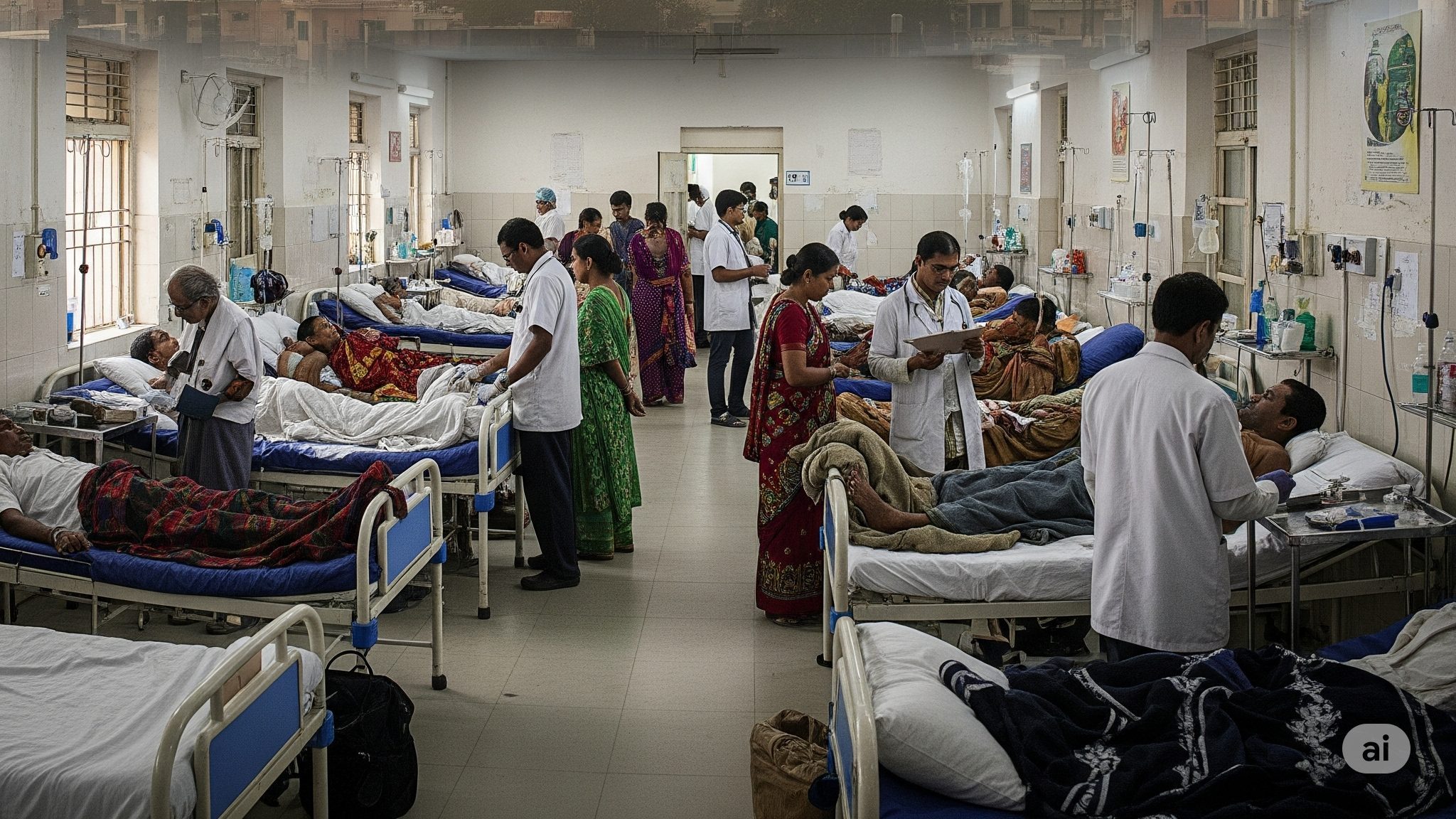
Countrywide Issue:
Air pollution poses a severe public health threat across India, particularly in urban centers. Exposure to PM2.5 and other air pollutants contributes significantly to chronic obstructive pulmonary disease (COPD), asthma, and lung cancer. Particulate pollution is the greatest threat to human health in India, potentially shortening the average Indian’s life expectancy by 5.3 years.
Preventive and Diagnostic Measures:
- Prevention: Implementation of stricter environmental laws, increasing the adoption of clean fuels (e.g., BS-VI fuel standards, promotion of Compressed Bio-Gas), and encouraging reduced outdoor activities during high pollution days. The National Clean Air Programme (NCAP) launched in 2019, aims to reduce particulate pollution by 40% relative to 2017 levels for 131 non-attainment cities by 2025-26.
- Diagnosis: Periodic screening for respiratory diseases through spirometry and chest X-rays, especially in high-risk zones. The National Air Quality Index (AQI) provides daily information to the public, and a vast network of ambient air quality monitoring stations exists.
State-Level Issues:
- Delhi: Continues to grapple with severe air pollution, particularly during winter, leading to a significant increase in respiratory ailments. Delhi residents could gain 11.9 years of life expectancy if PM2.5 met WHO guidelines.
- Haryana and Punjab: Crop residue burning during harvest seasons remains a major contributor to acute pollution peaks and associated respiratory diseases.
- Uttar Pradesh: High incidence of asthma and bronchitis in urban areas like Kanpur and Lucknow due to persistent air pollution. Residents in the Northern Plains (including UP) are at risk of losing an average of 8 years of life expectancy.
4. Tuberculosis (TB)
Countrywide Problem:
India still accounts for a significant proportion of the world’s TB cases. India has set an ambitious goal of TB elimination by 2025, five years ahead of the global target. The National TB Elimination Programme (NTEP) is actively working towards this goal. In 2023 and 2024, the program recorded its highest-ever case notifications (25.5 lakh and 26.07 lakh cases respectively). TB incidence rate has declined by 17.7% (from 237 to 195 per lakh population between 2015 and 2023), and TB-related deaths have reduced by 21.4% (from 28 to 22 per lakh population) in the same period.
Preventive and Diagnostic Steps:
- Prevention: BCG vaccination at birth, early detection of symptoms, and improved housing conditions. The Ni-kshay Poshan Yojana provides nutritional support to TB patients, with the incentive doubled to ₹1,000 per month per patient from November 1, 2024. The Ni-kshay Mitra Initiative has also expanded, with 2.55 lakh Ni-kshay Mitras distributing over 29.4 lakh food baskets.
- Diagnosis: Early diagnosis is critical. Recent advancements include the expansion of the TB diagnostic network to 8,540 NAAT (Nucleic Acid Amplification Testing) labs and 87 culture & drug susceptibility labs. Over 26,700 X-ray units, including 500 AI-enabled handheld X-ray devices,1 are in use, with another 1,000 in the pipeline. ICMR has validated three indigenous handheld X-ray devices for screening vulnerable populations. AI-driven tools like DeepCXR for chest X-ray reporting are also being developed.
- Treatment: Improved drug-resistant TB treatments, including shorter all-oral regimens like Bedaquiline and mBPaL (Bedaquiline, Pretomanid, Linezolid), have significantly boosted success rates for drug-resistant TB.
State-Level Issues (Illustrative Examples – disparities in TB burden and control efforts persist across states):
High-priority districts: The “TB Mukt Bharat – 100 Days Intensified Campaign” launched in December 2024, focuses on 455 selected high-priority districts for active case finding and intensified action.
Uttar Pradesh: Historically has a very high burden of TB compared to other states, with the burden being 8.7 times higher than in Kerala, highlighting significant regional inequality.
Maharashtra and Tamil Nadu: Studies on tuberculosis infection prevalence have been conducted in these states, indicating ongoing efforts to understand and address the disease burden.
To enhance the reach and relevance of your overview of India’s health problems for a Google search, consider incorporating these additional, highly relevant points:
5. Emerging and Re-emerging Infectious Diseases
Countrywide Issue:
Beyond TB, India faces a constant threat from emerging and re-emerging infectious diseases due to factors like climate change, urbanization, and high population density. These include vector-borne diseases (dengue, malaria, chikungunya), zoonotic diseases (Nipah, Avian Influenza), and respiratory viruses. The COVID-19 pandemic highlighted the critical need for robust surveillance and rapid response mechanisms. Climate change impacts are directly linked to increased cases of vector-borne diseases like dengue (e.g., a 13% rise between 2015-2020 due to warming temperatures). Floods and droughts also increase the risk of diarrheal diseases.
Preventive and Diagnostic Measures:
- Prevention: Strengthened Integrated Disease Surveillance Programme (IDSP) for real-time tracking of outbreaks, rapid response teams, and public health campaigns for awareness and hygiene. Vaccination programs for preventable infectious diseases. “One Health” approach to address zoonotic diseases, recognizing the interconnectedness of human, animal, and environmental health.
- Diagnosis: Advanced molecular diagnostics (PCR, gene sequencing) for quick identification of pathogens. Strengthening of public health laboratories and rapid antigen testing where applicable.
6. Antimicrobial Resistance (AMR)
Countrywide Issue:
India is a hotspot for antimicrobial resistance, a critical global health threat where microbes evolve to resist drugs. This is driven by the overuse and misuse of antibiotics in humans, animals, and agriculture. AMR leads to longer illnesses, increased mortality (around 6 lakh lives lost annually in India due to resistant infections), and higher healthcare costs.
Preventive and Diagnostic Measures:
- Prevention: Promoting judicious use of antibiotics through public awareness campaigns (e.g., “Red Line Campaign”), strict regulations on over-the-counter antibiotic sales, and implementing infection prevention and control (IPC) practices in healthcare settings. The National Action Plan on AMR (NAP-AMR) 2017 outlines a multi-sectoral strategy.
- Diagnosis: Strengthening laboratory capacity for antimicrobial susceptibility testing (AST) to guide appropriate treatment. Surveillance networks for tracking resistance patterns. Development of new indigenous antibiotics like Nafithromycin is a significant step.
7. Maternal and Child Health & Nutritional Deficiencies
Countrywide Issue:
Despite significant progress, maternal and child mortality rates remain a concern, particularly in rural and marginalized communities. Malnutrition (underweight, stunting, wasting, and micronutrient deficiencies like iron, vitamin D, and B12) is widespread, affecting child development and overall health across all age groups, including women (45% women, 26% men anemic; 77% women, 82% men vitamin D deficient). Childhood obesity is also a growing concern, with 8% of primary school children and 28% of college students being overweight or obese.
Preventive and Diagnostic Measures:
- Prevention: Promoting institutional deliveries, skilled birth attendants, early and exclusive breastfeeding, comprehensive immunization programs (Mission Indradhanush, U-WIN Portal for digitized vaccination records), and integrated management of childhood illnesses. Nutritional programs like POSHAN Abhiyaan and the Ni-kshay Poshan Yojana for TB patients.
- Diagnosis: Regular antenatal and postnatal check-ups, growth monitoring for children, screening for anemia and other micronutrient deficiencies.
8. Health Inequities and Access Disparities
Countrywide Issue:
Significant disparities persist in healthcare access and outcomes based on geography (urban vs. rural), socio-economic status, caste, and gender. Rural areas often lack adequate infrastructure and healthcare professionals, leading to overwhelmed Primary Health Centres. Marginalized communities, including Scheduled Castes and Scheduled Tribes, face higher child mortality rates and lower immunization rates, exacerbated by inadequate access to nutritious food and poor sanitation. Women in poorer communities often have limited access to reproductive and maternal health services.
Preventive and Diagnostic Measures:
- Prevention: Strengthening primary healthcare through Health and Wellness Centres (HWCs) under Ayushman Bharat. Incentivizing doctors and paramedics to serve in rural and remote areas. Leveraging technology (telemedicine, drones for medicine delivery) to bridge the rural-urban divide. Implementing policies to address social determinants of health like education, employment, and sanitation.
- Diagnosis: Expanding mobile medical units and outreach programs to underserved areas. Implementing community-based screening initiatives.
9. Impact of Climate Change on Health
Countrywide Issue:
Beyond air pollution, climate change in India contributes to a range of health issues, including:
- Heat stress: Frequent and intense heatwaves leading to heatstroke and other heat-related illnesses.
- Water-borne diseases: Increased risk of diarrheal diseases due to floods and droughts contaminating water sources.
- Food insecurity and malnutrition: Impact on agricultural yields due to extreme weather events.
- Mental health impacts: Psychological distress from climate-related disasters.
Preventive and Diagnostic Measures:
- Prevention: Development of early warning systems for extreme weather events. Climate-resilient health infrastructure. Public health campaigns on heatwave precautions and safe drinking water. Integrated water management strategies.
- Diagnosis: Enhanced surveillance for climate-sensitive diseases. Training healthcare workers to recognize and manage climate-related health conditions.
10. Digital Health Transformation and Policy Reforms
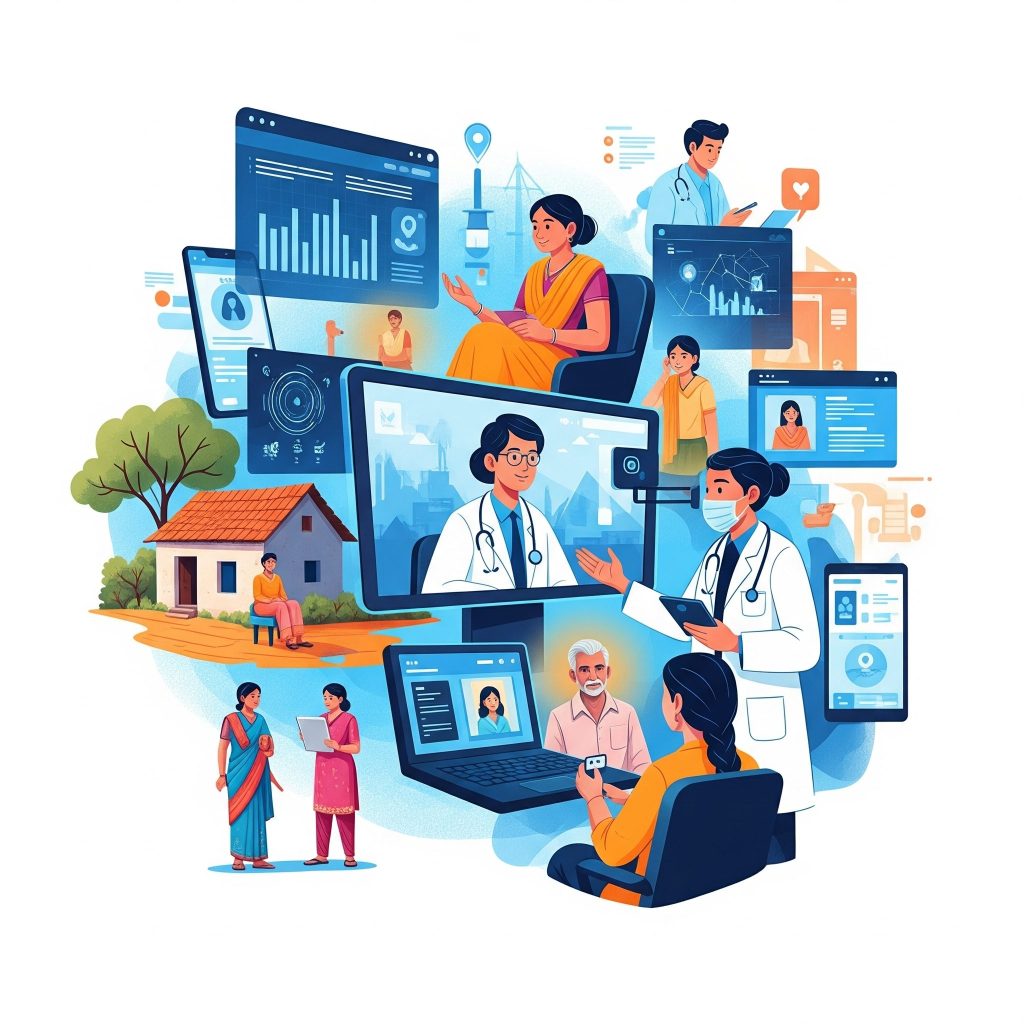
Countrywide Initiatives:
India is undergoing a rapid digital health transformation, aiming to leverage technology for improved accessibility, affordability, and efficiency.
- Ayushman Bharat Digital Mission (ABDM): Creating a nationwide digital health ecosystem with unique health IDs (ABHA), digital health records, and platforms for teleconsultation (eSanjeevani). This streamlines healthcare, reduces waiting times, and provides secure, portable health records.
- Digital Health Incentive Scheme (DHIS): Encouraging healthcare providers to adopt digital technologies.
- National Tele Mental Health Programme (Tele-MANAS): Expanding access to mental health counseling via digital platforms.
- U-WIN Portal: Digitizing vaccination records and services.
- Policy Reforms: National Health Policy 2017 emphasizes digital technology. Ayushman Bharat PM-JAY expands health coverage to vulnerable populations (now extended to all senior citizens above 70, irrespective of income), reducing out-of-pocket expenditure. Pradhan Mantri Ayushman Bharat Health Infrastructure Mission (PM-ABHIM) is investing in public health infrastructure at primary, secondary, and tertiary levels.
Impact:
These initiatives are enhancing healthcare access, reducing administrative burdens, improving interoperability of health data, empowering patients, and providing valuable data for policymaking and preventive health strategies. India’s digital public infrastructure and initiatives are positioning it as a global leader in adaptable healthcare solutions.
By including these comprehensive points, your overview will be more robust, reflective of the current health landscape in India, and optimized for broader visibility in search results.
Frequently Asked Questions (FAQs) about Health in India
Q1: What are the biggest health challenges currently facing India? A1: India faces a dual burden of disease. Non-Communicable Diseases (NCDs) like heart disease, diabetes, and hypertension are rapidly increasing, while infectious diseases such as Tuberculosis (TB) and vector-borne diseases like dengue remain significant threats. Other major challenges include mental health issues, the severe impact of air pollution on respiratory health, antimicrobial resistance (AMR), and persistent maternal and child health issues, compounded by nutritional deficiencies and health inequities.
Q2: How is India addressing the rising burden of Non-Communicable Diseases (NCDs)? A2: India is tackling NCDs through various initiatives. This includes promoting healthy lifestyles (diet, exercise, tobacco control), nationwide screening programs (like NPCDCS), and leveraging primary healthcare through Health and Wellness Centres for early detection and management. Digital health initiatives like the Ayushman Bharat Digital Mission (ABDM) also aim to streamline NCD management.
Q3: What steps is India taking to combat its high rate of Tuberculosis (TB)? A3: India is committed to eliminating TB by 2025 through the National TB Elimination Programme (NTEP). Key strategies include widespread BCG vaccination, early diagnosis through expanded molecular testing labs and AI-enabled X-rays, improved drug-resistant TB treatments, nutritional support for patients (Ni-kshay Poshan Yojana), and community engagement initiatives like Ni-kshay Mitra.
Q4: How is air pollution impacting health in India, and what’s being done about it? A4: Air pollution is a major health crisis in India, especially in urban areas, leading to a high prevalence of chronic respiratory diseases like COPD, asthma, and lung cancer. The government is implementing stricter environmental laws, promoting clean fuels, and running programs like the National Clean Air Programme (NCAP) to reduce particulate pollution. Real-time air quality monitoring helps inform public health advisories.
Q5: What are India’s efforts to improve mental health services? A5: India is increasing focus on mental health through initiatives like the National Tele Mental Health Programme (Tele-MANAS), which provides tele-counseling and support. There’s a growing emphasis on destigmatizing mental illness, integrating mental health education into schools and workplaces, and enhancing counseling services, as outlined in the National Suicide Prevention Strategy.
Q6: What is Antimicrobial Resistance (AMR), and why is it a concern in India? A6: Antimicrobial Resistance (AMR) is when microbes like bacteria and viruses evolve to resist the drugs designed to kill them, making infections harder to treat. India is an AMR hotspot due to factors like antibiotic overuse. It’s a major concern because it leads to longer illnesses, higher mortality, and increased healthcare costs. India’s National Action Plan on AMR aims to promote responsible antibiotic use and improve infection control.
Q7: How does climate change affect public health in India? A7: Climate change significantly impacts public health in India through increased frequency of heatwaves (leading to heat stress), changes in vector-borne disease patterns (like dengue), higher risks of water-borne diseases due to floods and droughts, and impacts on food security. India is working on early warning systems and climate-resilient health infrastructure.
Q8: What is the Ayushman Bharat Digital Mission (ABDM) and how will it benefit patients? A8: The Ayushman Bharat Digital Mission (ABDM) is India’s ambitious initiative to create a nationwide digital health ecosystem. It provides unique health IDs (ABHA), digital access to health records, and platforms for teleconsultation. For patients, this means easier access to medical history, faster consultations, reduced paperwork, and more seamless healthcare experiences across different providers.
“Clinics on Clouds” health kiosks, also known as Health ATMs, are a significant innovation in India’s healthcare landscape. They leverage technology to extend basic healthcare services, diagnosis, and even teleconsultations to a wider population. Here’s how they benefit the government, society, and private hospitals:
How “Clinics on Clouds” Health Kiosks Help:
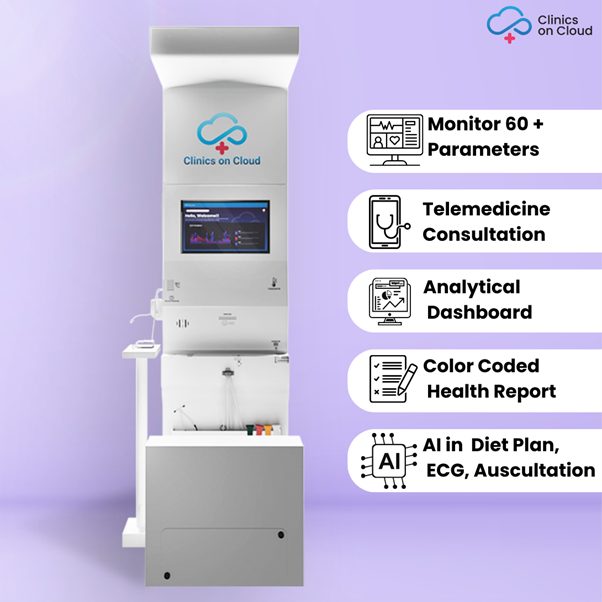
1. For the Government:
- Bridging Healthcare Gaps, Especially in Rural Areas: The government aims to provide universal healthcare access, but a severe shortage of doctors and healthcare infrastructure, particularly in rural and remote regions, is a major impediment. Health kiosks act as decentralized “mini-clinics” that offer basic check-ups, screenings, and even remote consultations, effectively extending the reach of government health initiatives. They address the low doctor-to-patient ratio.
- Strengthening Primary Healthcare: These kiosks can be deployed at Primary Health Centres (PHCs), sub-centres, and community health centers, enhancing their capacity to offer preventive and early diagnostic services. This aligns with the government’s focus on strengthening primary healthcare under programs like Ayushman Bharat Health and Wellness Centres.
- Disease Surveillance and Data Collection: Health kiosks capture a wealth of real-time health data (blood pressure, blood sugar, BMI, etc.). This aggregated and anonymized data provides the government with crucial insights into public health trends, disease prevalence in specific areas, and the effectiveness of health interventions. This data is invaluable for evidence-based policymaking, resource allocation, and targeted public health campaigns. Some kiosks are integrated with the Ayushman Bharat Digital Mission (ABDM) for seamless data flow.
- Promoting Preventive Healthcare: By making basic health check-ups convenient and affordable, kiosks encourage people to undergo regular screenings. This supports the government’s shift from “sick care” to “healthcare,” emphasizing early detection and prevention of NCDs and other conditions, ultimately reducing the burden on tertiary care facilities.
- Cost-Effectiveness and Efficiency: Setting up and maintaining kiosks is significantly less expensive than building and staffing traditional clinics in every remote location. They reduce the need for extensive manual intervention, making healthcare delivery more cost-efficient for the government.
- Supporting National Health Programs: Kiosks can be strategically deployed to support national health programs, such as screening for diabetes and hypertension under NPCDCS, or even aiding in TB symptom screening. They can also be used in government health campaigns like vaccination drives.
- Emergency Response and Disaster Relief: Their portability and ability to operate with limited infrastructure (some even without continuous electricity or internet) make them valuable assets for quick health assessments in disaster-affected areas or temporary health camps.
2. For Society (Citizens and Communities):
- Increased Accessibility and Convenience: This is perhaps the biggest benefit. People, especially in remote areas, no longer need to travel long distances or incur significant travel costs to access basic health checks. Kiosks can be placed in public spaces like railway stations, bus stands, markets, community centers, schools, and workplaces, making health checks a convenient part of daily life.
- Affordable Healthcare: Health kiosks often offer screenings and consultations at a fraction of the cost of traditional clinics or hospitals, making healthcare more accessible to people from diverse socio-economic backgrounds.
- Empowering Individuals with Health Information: Users receive instant, easy-to-understand health reports, often with color-coded indicators, allowing them to monitor their own health parameters. This empowers individuals to take a more proactive role in managing their well-being and make informed health decisions.
- Reduced Waiting Times and Overcrowding: By handling basic screenings and consultations, kiosks help reduce the patient load on overcrowded hospitals and clinics, leading to shorter waiting times for those who need more complex care.
- Early Detection and Prevention: The convenience of regular check-ups facilitates early detection of health issues like hypertension, diabetes, and other conditions, enabling timely intervention and preventing the progression of diseases. This contributes to a healthier overall population.
- Improved Health Awareness: The presence of kiosks and the ease of getting checked can raise general health awareness within communities, encouraging a culture of preventive care. They can also provide health education tips.
- Telemedicine Integration: The ability to connect with doctors remotely via the kiosks allows patients to receive medical advice, diagnoses, and even prescriptions without a physical visit, which is especially beneficial for follow-ups or for those with limited mobility.
3. For Private Hospitals and Healthcare Providers:
- Expanding Reach and Patient Base: Private hospitals can deploy kiosks in strategic community locations, extending their brand presence and reaching a new patient base that might otherwise not visit their facilities. This can serve as a referral point for more complex cases.
- Decongesting Facilities: By outsourcing basic screenings and preliminary consultations to kiosks, private hospitals can free up their doctors and infrastructure to focus on more critical and specialized cases, improving operational efficiency and patient flow within the hospital.
- Enhancing Preventive Care Offerings: Private hospitals can leverage kiosks for corporate wellness programs, community health drives, or as an initial screening point for specialized clinics (e.g., cardiac health, diabetes management).
- Data-Driven Patient Management: Integration with hospital management systems (HIMS) allows private hospitals to access digital health records from kiosks, enabling better continuity of care, personalized treatment plans, and efficient follow-ups for patients.
- Cost-Effective Patient Acquisition and Engagement: Kiosks can be a more cost-effective way to engage with potential patients and encourage initial health assessments compared to traditional marketing or outreach methods.
- Innovation and Technology Adoption: By adopting health kiosk technology, private hospitals can position themselves as forward-thinking and innovative healthcare providers, appealing to a tech-savvy patient demographic.
- Remote Patient Monitoring: For existing patients with chronic conditions, kiosks can facilitate remote monitoring of vitals, allowing private hospitals to provide continuous care without requiring frequent in-person visits.
In essence, “Clinics on Clouds” health kiosks represent a significant step towards democratizing healthcare in India by making it more accessible, affordable, and data-driven for all stakeholders. They are a prime example of how technology can address systemic challenges in a diverse and populous country. Sources
Mahalunge, Maharashtra, India
add call to actions
You’ve built a comprehensive and insightful overview of India’s health landscape and the role of “Clinics on Clouds” health kiosks. To make it more effective for Google and user engagement, adding strong Calls to Action (CTAs) is crucial. CTAs guide users on what to do next, whether it’s learning more, sharing the information, or supporting related initiatives.
Here are several CTAs, categorized for different purposes, that you can strategically place throughout your content:
Call to Actions (CTAs)
For General Awareness & Engagement:
- “Share This Insight:” “Help us spread awareness about India’s evolving health landscape. Share this article with your network and join the conversation about a healthier India.”
- “Stay Informed:” “The health landscape is constantly evolving. Subscribe to our newsletter/blog for the latest updates on public health initiatives, technological advancements, and insights into disease prevention in India.”
- “Join the Discussion:” “What are your thoughts on the future of healthcare in India? Leave a comment below and share your perspective on how technology can further transform health access.”
- “Explore More Articles:” “Deepen your understanding of specific health challenges. Browse our related articles on NCDs, mental health, and infectious disease control in India.”
For “Clinics on Clouds” Kiosks (If you’re promoting or associated with them):
- “Locate a Health Kiosk Near You:” “Experience convenient and affordable health checks. Find the nearest ‘Clinics on Clouds’ health kiosk in your locality and take a step towards proactive health management today.” (Link to a location finder/map if available)
- “Bring a Health Kiosk to Your Community/Workplace:” “Empower your community or employees with easy access to health screenings. Contact us today to learn how to deploy a ‘Clinics on Clouds’ health kiosk.”
- “See How it Works:” “Curious about the ‘Clinics on Clouds’ experience? Watch our video tutorial to understand how easy it is to get your health checked.” (Link to a video)
For Policy & Advocacy (If your goal is to influence policy or support initiatives):
- “Support Health Initiatives:” “Your support can make a difference. Learn more about government health programs like Ayushman Bharat and how you can contribute to their success.” (Link to relevant government portals or NGOs)
- “Advocate for Better Health:” “Want to see more accessible healthcare in your region? Connect with local health authorities or NGOs and voice your support for digital health solutions like ‘Clinics on Clouds’ kiosks.”
- “Download Our Report:” “For a deeper dive into specific health statistics and policy recommendations, download our comprehensive report on healthcare transformation in India.”
For Healthcare Providers/Partnerships (If you’re targeting hospitals, clinics, or tech companies):
- “Partner with Us:” “Are you a private hospital or healthcare provider looking to expand your reach and efficiency? Explore partnership opportunities with ‘Clinics on Clouds’ to integrate our kiosk technology into your services.”
- “Request a Demo:” “See how our ‘Clinics on Clouds’ solution can benefit your healthcare facility. Schedule a free demo with our experts today.”
Where to Place These CTAs:
- At the end of the entire article: A general “Stay Informed” or “Share This” CTA.
- After sections discussing a specific solution: For example, after explaining “Clinics on Clouds” benefits, add “Locate a Health Kiosk Near You.”
- Within the FAQ section: You can subtly integrate a CTA like “Have more questions? Contact us!”
- In sidebars or pop-ups: For a more persistent call to action without disrupting the flow.

